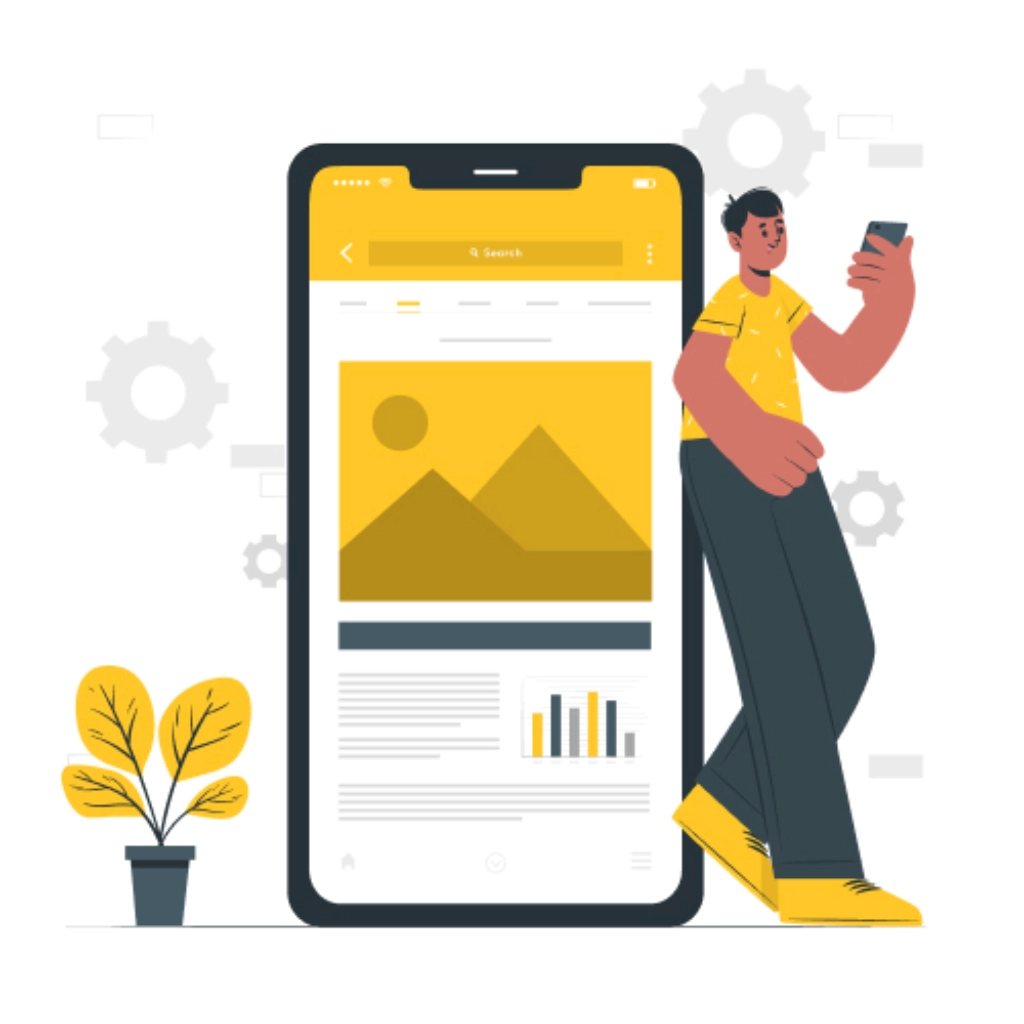Ever opened a website on your phone and had to pinch, zoom, scroll sideways, or squint at microscopic buttons? Chances are, you didn’t stay long. Neither do your customers.
In Singapore, where over 90% of users browse the web primarily on mobile, having a desktop-first website is like putting up a signboard that only works if someone stands in the right spot, at the right angle. That’s not good enough anymore.
This blog walks you through why mobile-first web design is no longer a “nice-to-have” but a business essential. Especially if you’re a growing brand that cares about visibility, trust, and getting more leads without wasting ad money.
Mobile-First Is Now A Competitive Edge, Not A Buzzword
Let’s get this out of the way: mobile-first is not the same as mobile-friendly.
- Mobile-friendly means your desktop website adjusts after the fact to fit smaller screens.
- Mobile-first means the entire design starts with mobile in mind (from layout to speed to usability), then scales up for larger screens.
It’s a strategy, not a patch.
In Singapore, where smartphones are the default browsing device, building mobile-first websites is no longer just about keeping up; it’s about getting ahead. Google agrees. Since 2019, Google has ranked your site primarily based on its mobile version, not desktop. If your mobile layout is sluggish, clunky, or confusing, your rankings take the hit, even if your desktop site is spotless.
Here’s what mobile-first prioritises:
- Fast load times, even on 4G
- Easy-to-tap buttons (no more fat-finger rage)
- Clean, legible text without needing to zoom
- Clear, short paths to action, no endless scrolling
For business owners, this means less bounce, more trust, and ultimately, better conversions from users who are already on the move.
What Mobile-First Really Looks Like in Practice
Let’s break down what a properly mobile-first site does that your “responsive” layout probably doesn’t.
It’s not just about shrinking things to fit, it’s about rebuilding your site’s experience around the way people actually browse on mobile:
✅ Prioritised Content
No one wants to scroll through a desktop homepage compressed into a vertical scrollfest. Mobile-first design puts the most important info first, your value prop, contact buttons, and calls to action are visible without swiping three times.
✅ Tap-Ready UX
Menus are simplified. Buttons are big enough to tap comfortably without needing surgeon-level precision. Thumb zones are considered. No rage-clicking or accidental misfires.
✅ Fast Load Times
Mobile-first design strips down bloated code and image sizes. Images load responsively (think: WebP format), animations are used sparingly, and scripts don’t drag down performance.
✅ Single Task Focus
Each page guides the user to one key action: book, call, buy, or enquire. No noise. No distractions. Just clarity and momentum.
How Mobile-First Impacts SEO, Conversions, and Trust
Mobile-first is a design philosophy, but it affects your bottom line.
Google Indexes Your Mobile Site First
Since 2019, Google’s algorithm has prioritised the mobile version of your site when ranking in search results. If your mobile UX is poor, you’ll lose visibility, regardless of how great your desktop version looks.
Bad Mobile UX Kills Conversions Silently
Most users won’t message to say your site’s annoying. They’ll just leave.
A slow site or a confusing menu can quietly drain your ad budget and bleed trust. And once they bounce, they rarely return.
Clean Mobile Design Builds Credibility
A fast, elegant mobile experience shows that your business is modern, capable, and easy to engage with. Whether you’re a boutique café or a B2B logistics firm, your mobile site is now your first impression and your silent salesperson.
According to a Google study, 61% of users are unlikely to return to a mobile site they had trouble accessing, and 40% will go to a competitor instead.
That’s why mobile-first isn’t just about adapting, it’s about competing.
Why Singapore SMEs Can’t Afford to Wait
If you’re running a small or mid-sized business in Singapore, every site visit matters. You don’t have the luxury of wasted clicks or silent drop-offs.
Here’s what happens when your website fails to deliver a proper mobile experience:

You lose ready-to-buy customers
Most users browse while commuting or in between tasks. When a site takes too long or feels clunky, they don’t stick around. They shift attention instantly to someone who makes things easy.
Your ads start leaking budget
Paid campaigns may bring traffic, but poor mobile performance kills conversions. A slow landing page or fiddly contact form is all it takes to waste that spend.
Search rankings drop silently
Google evaluates mobile usability first. If your mobile site struggles with speed or structure, your position in search results slips, quietly but consistently.
A mobile-first redesign removes friction. For businesses trying to grow with limited bandwidth, that shift can unlock real momentum.
Real Signs Your Website Needs a Mobile-First Overhaul
Not sure if your site is doing more harm than good? Run through this quick check. No technical know-how required.
Say “yes” to more than one of these, and it’s probably time for a rethink:
- The site takes longer than 3 seconds to load on mobile data
- Text looks cramped or forces zooming
- Tapping buttons feels awkward or unreliable
- Menus take too long to navigate
- Forms are long, clunky, or feel like a chore to complete
- Mobile visitors drop off before reaching key actions
- People often message you asking for things already on the site
Each of these leads to lost trust, lower conversions, and missed opportunities, especially when users compare you with competitors offering smoother digital journeys.
How Singapore Best Web Design Builds (SBWD) with Mobile in Mind
Many agencies talk about mobile responsiveness. We start with mobile at the core.
At Singapore Best Web Design, our approach isn’t just about adjusting layouts. It’s about designing smarter, faster, and with purpose, especially for the way people in Singapore browse, click, and buy.
Here’s what that looks like:
Built for Speed
We optimise every page to load fast on 4G, compressing images, using clean code, and applying performance-first development practices. Visitors don’t wait. They see your offer instantly.
Designed for Thumbs
We prioritise touch interaction from the wireframe stage. Buttons are comfortably placed, navigation is swipe-friendly, and actions are always easy to access, even with one hand.
Content with a Clear Flow
Our layouts follow how people naturally scan content on a small screen. No clutter. Just a clear message, sharp visuals, and CTAs that convert.
SEO and Analytics Built In
We integrate metadata, schema markup, and tracking tools, so your mobile site performs well in search and gives you the insights to improve.
With over 500 projects completed locally, we’ve refined what works for Singapore brands, and we bake that experience into every mobile-first build.
Think Your Site’s Fine? Run This 60-Second Test
Here’s a simple, honest check you can do right now.
- Open your website on your phone.
- Imagine you’re a customer with zero patience.
- Try to:
- Load the homepage on mobile data
- Tap a service/product link without error
- Find the contact number within 5 seconds
- Complete a form with one thumb
- Understand your offering without scrolling 5 times
If any of that felt awkward, unclear, or time-consuming, you already know what your users are going through.
This test doesn’t need tools or reports. It just needs brutal honesty.
And if something felt off, you don’t need a total rebuild. You need a mobile-first strategy that fixes what matters, without blowing up what works.
What Happens If You Wait Too Long?
The truth? Most businesses don’t realise their site is leaking trust and traffic until results dip, and even then, they blame the wrong things.
Here’s what tends to happen:
- Ads stop converting, even though traffic looks fine
- Organic rankings slowly slide, despite regular updates
- Customers start calling instead of using the site, because they couldn’t navigate it properly
- Competitors with cleaner mobile experiences start getting more word-of-mouth and referrals
These outcomes aren’t random. They’re the ripple effects of a site that underperforms where it matters most: mobile.
And the longer you delay a proper fix, the harder it becomes to recover lost visibility, reputation, and user confidence.
Ready to Build a Mobile Experience That Wins Customers?
A great mobile-first site does more than “look good on a phone.” It removes friction. It earns trust. It performs, whether the visitor is booking a class, browsing your product, or looking for a quick answer.
At Singapore Best Web Design, we design and build with mobile-first as our default, not an afterthought.
- We help businesses align with government grants
- We handle everything in-house, no outsourcing surprises
- We offer structured support for 30/60/90 days post-launch
- We design for real outcomes: faster load times, more leads, better rankings
You don’t need to rebuild your brand. You just need a site that matches the way your customers already live, browse, and buy.
Book a free strategy call. We’ll audit your current site, show you what matters, and help you take the next step without pressure and without the tech being overwhelmed.

Frequently Asked Questions
How do I know if my current site is mobile-first or just responsive?
Try loading your site on a mobile device. If key actions are hard to find, text feels cramped, or the layout just shrinks the desktop version, you’re likely working with a responsive site, not a mobile-first one.
Do mobile-first websites cost more to build?
Not necessarily. A mobile-first site focuses on what matters most, which can often streamline the design and reduce unnecessary features, making it efficient both in cost and user experience.
Can mobile-first design help with SEO in Singapore?
Yes. Google ranks websites based on mobile performance first. A fast, easy-to-use mobile site improves visibility in search results and lowers bounce rates.











